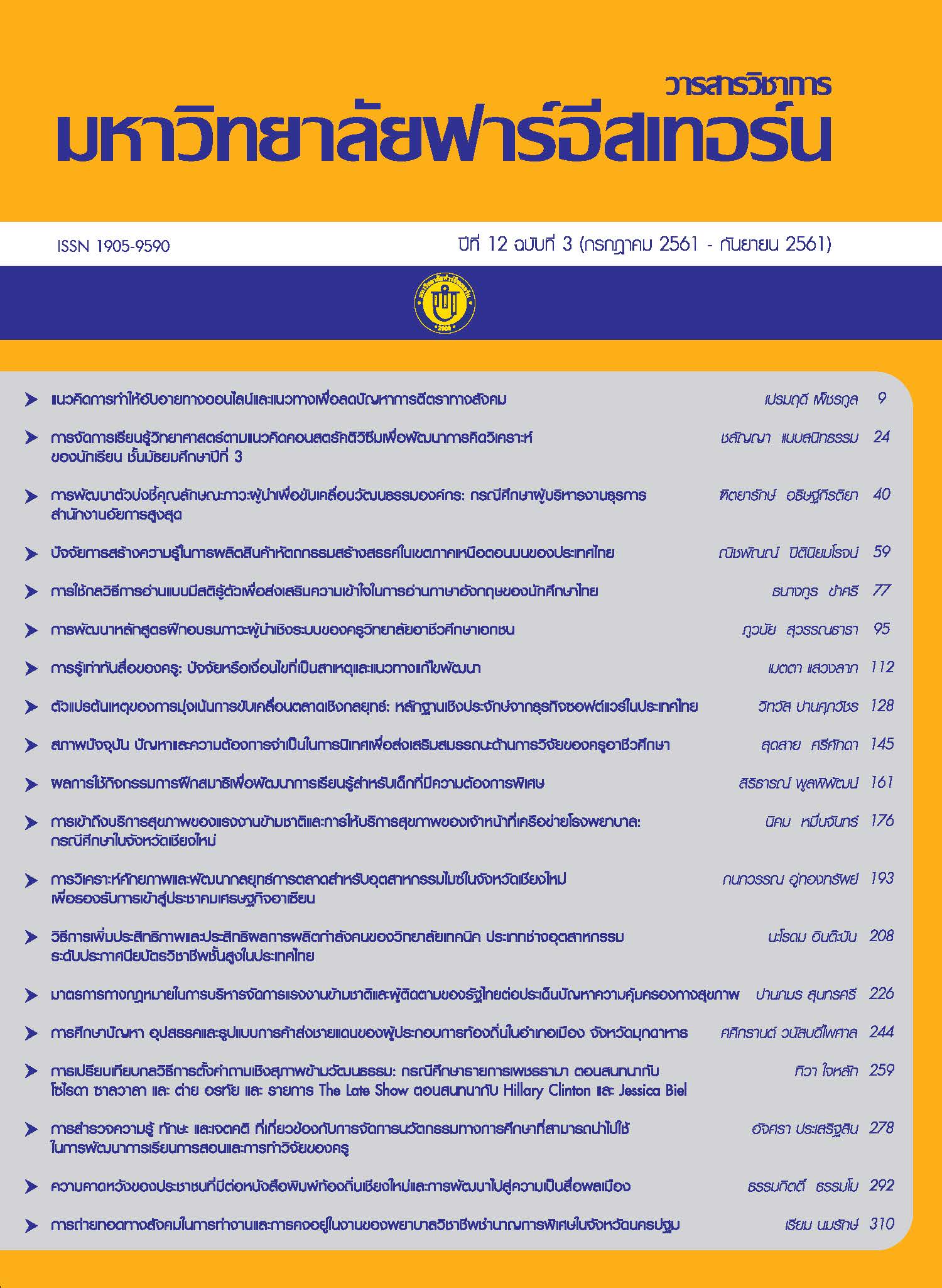The Concept of Online Shaming and the Solution for Reducing Stigma
Main Article Content
Abstract
การศึกษาครั้งนี้เป็นการกล่าวถึงแนวคิด “การควบคุมทางสังคม” ในบริบท “การทำให้อับอายทางออนไลน์” ซึ่งโดยทั่วไปการควบคุมทางสังคมที่เป็นทางการจะเป็นหน้าที่ของกระบวนการยุติธรรมในการตัดสิน ลงโทษและแก้ไขบำบัดฟื้นฟู แต่ตรงข้ามกับสังคมออนไลน์ที่ใช้การควบคุมทางสังคมแบบไม่เป็นทางการซึ่งมีการใช้รูปแบบการต่อต้านทางสังคมต่อบุคคลผู้ละเมิดบรรทัดฐานทางสังคมผ่านทางอินเทอร์เน็ต จนทำให้บุคคลเกิดความอับอายและถูกผู้คนในสังคมประทับตรา ทั้งๆ ที่บุคคลนั้นยังไม่ได้ถูกตัดสินโดยหน่วยงานในกระบวนการยุติธรรม การศึกษาครั้งนี้จึงมุ่งหวังที่จะแก้ไขปัญหาดังกล่าวโดยใช้ทฤษฎีที่เกี่ยวข้องกับการตีตรามาช่วยในการสนับสนุนให้เหยื่อจากการถูกทำให้อับอายทางอินเทอร์เน็ตได้รับความเป็นธรรมและอยู่ร่วมกับผู้คนในชุมชนสังคมออนไลน์ได้อย่างปกติสุข
This study focus the concept of social control in discussions of online shaming. In general, formal social control, most closely associated with the criminal justice system which was judge, punishment and rehabilitation. This was then contrasted with social online, it was informal social control where public shaming as a form of social sanction to people who transgressed social norms via internet. There is the purpose of humiliation and social stigmatization by internet crowd while it’s not been judged from justice officials. This paper discuss the problems and solutions related to the Shaming Theory, as well as their usefulness in the context of online shaming for justice the victim’s reintegration into the online community.
Article Details
1. Any views and comments in the Journal of Social Innovation and Lifelong Learning are the authors’ views. The editorial staff have not to agree with those views and it is not considered as the editorial’s responsibility.
2. The responsibility of content and draft check of each article belongs to each author. In case, there is any lawsuit about copyright infringement. It is considered as the authors’ sole responsibility.
3. The article copyright belonging to the authors and The Far Eastern University are copyrighted legally. Republication must be received direct permission from the authors and The Far Eastern University in written form.
References
https://www.js100.com/th/site/post_share/view/25700
ณัฐรัชต์ สาเมาะ และคณะ. (2556). การรับรู้ของเยาวชนต่อการรังแกในพื้นที่ไซเบอร์. วารสารพฤติกรรม
ศาสตร์เพื่อการพัฒนา, 6(1), 351-363.
ประชาชาติ. (2560). ส่อง “เพจดัง” เสนอมุม “เปรี้ยวฆ่าหั่นศพ” กับความสนใจข่าวอาชญากรรมระดับ
มโหฬารของคนไทย. สืบค้นเมื่อ 22 กันยายน 2560. จากhttps://www.prachachat.
net/news_detail.php?newsid=1496325137.
พัชราภา เอื้ออมรวนิช. (2560). สื่อมวลชน: เสรีภาพและความรับผิดชอบ Mass Media: Freedom and
Responsibility. วารสารวิชาการมหาวิทยาลัยฟาร์อีสเทอร์น. 11(4), 9-18.
โพสต์ทูเดย์. (2559). ความจริงจาก "ชายรองเท้ามีรู" เหยื่อโซเชียลผู้ถูกกล่าวหาว่า “โรคจิต”. สืบค้นเมื่อ 15 สิงหาคม 2560, จาก https://www.posttoday.com/social/general/444676.
เฟื่องลดา สราณี. (2559). “Cyberbully” กรณีศึกษากราบรถกู.ไทยรัฐออนไลน์. สืบค้นเมื่อ 6 กรกฎาคม 2560, จาก https://www.thairath.co.th/content/778602.
Beccaria, C. (1963). On Crimes and Punishments (introduction by Henry Paolucci, Trans.). New York: Macmillan.
Bonn, S. (2017). The Great Myth of White, Female Killers. Retrieved June 22, 2017, from:
https://www.psychologytoday.com/us/blog/wicked-deeds/201603/the-great-myth-
white-female-killers.
Braithwaite J. (1989). Crime, shame, and reintegration. Cambridge: Cambridge University Press.
Cheung, A. S. (2014). Revisiting privacy and dignity: online shaming in the global E-village. Laws, 3, 301 – 326.
Cowie, H. (2013). Cyberbullying and its impact on young people’s emotional health and well-being.The Psychiatrist, 37(5), 167-170.
Cullen, F.T., & Agnew, R. (2003). Criminological Theory Past to Present. Los Angeles: Roxbury Publishing Company.
Goffman, E. (1963). Stigma: Notes on the Management of Spoiled Identity. Englewood Cliffs, NJ: Prentice Hall.
Hou, Y., Jiang, T. & Wang, Q. (2017). Socioeconomic status and online shaming: The mediating role of belief in a just world. Computers in Human Behavior, 76, 19-25.
Johnston, L. (1996). What is vigilantism? British Journal of Criminology, 36, 220 – 236.
Kao, D. Y., Huang, F. F., Wang, S. J. (2009). Persistence and desistance: examining the impact of re-integrative shaming to ethics in Taiwan juvenile hackers. Computer law & security review, 25, 464 – 476.
Klonick, K. (2015). Re-shaming the debate: Social norms, shame, and regulation in an internet age. Maryland Law Review, 75(4), 1028 – 1065.
Kohm, S. A., (2009). Naming, shaming and criminal justice: Mass-mediated humiliation as entertainment and punishment. Crime media culture, 5(188). 187-205.
Laidlaw., B. E. (2017). Online shaming and the right to privacy. MDPI Journal, 6 (3). Doi:
10.20944/preprints201612.0112.v1.
Matos, M., Pinto-Gouviea, J., Gilbert, P., Duarte, C., &Figueiredo, C. (2015). The other as
Shamer Scale-2: Development and validation of a short version of a measure of
external shame. Personality an individual differences, 74, 6-11.
Mclure, H. (2000). The wild, wild web: The mythic American west and the electronic frontier.
The Western Historical Quarterly, 31, 457 – 476.
Skoric, M. M., Chua, J. P. E., Liew, M. A., Wong, K. H., & Yeo, P. J. (2010). Online shaming in
the Asian context: community empowerment or civic vigilantism? Surveillance &
Society, 8(2), 181 – 199.
Wehmhoener, K. A. (2010). Social norm or social harm: An exploratory study of internet
Vigilantism. Master of Science, Journalism and Mass Communication Graduate
Faculty Iowa State University.

